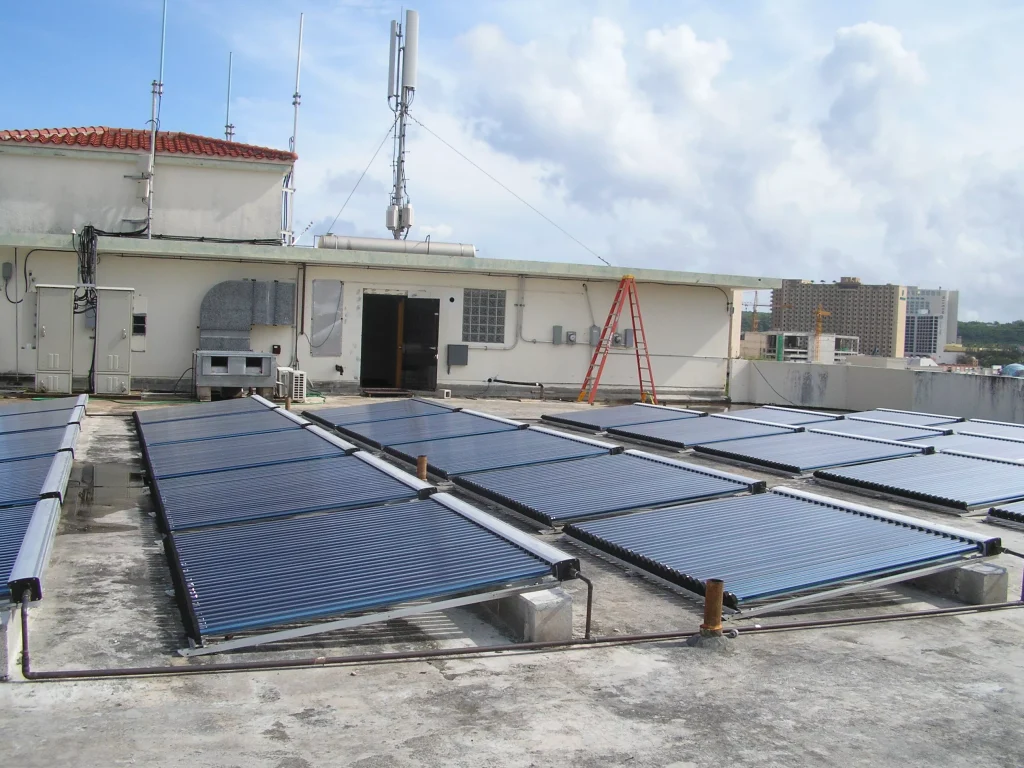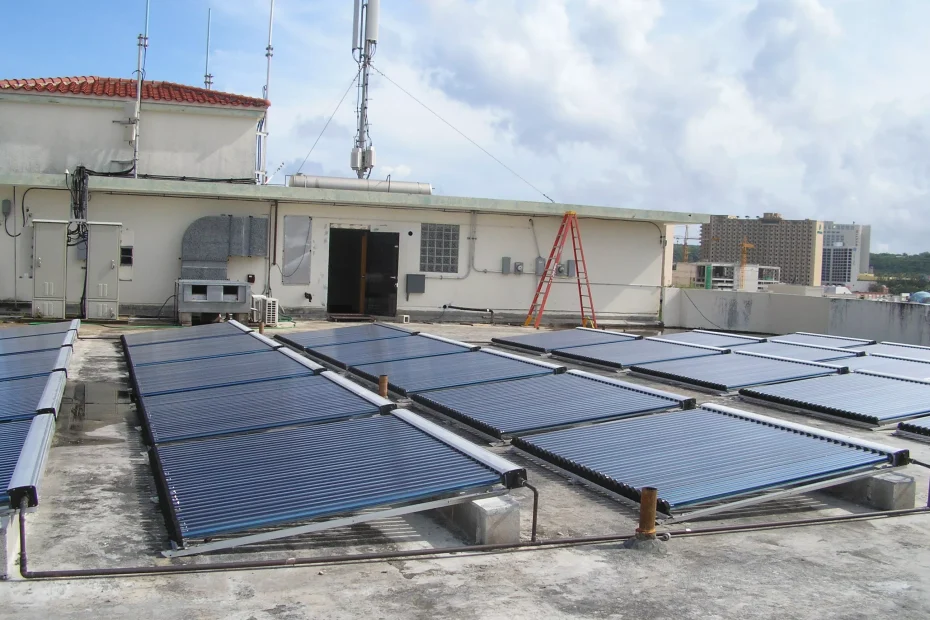
Solar energy can be used for domestic hot water production in hotels
The global trend in hotel units is leading to the creation of more and more energy efficient, green and smart buildings. As a result, entrepreneurs looking to the future realize that reducing their energy costs will immediately increase their competitiveness and profits.
The satisfaction of the guests from their stay is greatly influenced by the thermal comfort conditions that prevail in the hotel premises, while they do not accept compromises in the supply of Domestic Hot Water that they use.
Thus, a hotel, compared to other service companies, is in the first place in energy consumption, as it needs constant supply of Domestic Hot Water whatever its fullness, as well as air conditioning of areas with cooling in summer and heating in winter.
Do you want to be completely independent of the constant increases in fuel and electricity prices?
Today, there are significant energy and resource savings opportunities, especially in Domestic Hot Water Production, with the aim of low annual operating costs and fast depreciation time.
To create modern electromechanical energy-saving systems, the business hotelier must focus on using renewable energy sources as much as possible, as well as solutions with hybrid systems that combine individual subsystems to produce thermal energy that can be in one to make the most of the benefits of any technology.
Solar heat – The most economical Renewable Energy Source
Solar Systems find perfect application in Hotel Units, where energy requirements are high, achieving high energy saving rates.
The most important factor in choosing a solar heating system to use Domestic Hot Water is to achieve the right balance between the size of the installation (and therefore the initial cost) and the need to meet the needs.
Most companies are constant working to lower their operation cost. In hotels the water system is always an issue, because a lot of energy is needed here. In locations, where the sun is reliable shining, a solar water heating system is the first choice to produce solar hot water. The thermal energy needed is delivered by the sun for free and the technology is very environmentally friendly and sustainable.
As a kind of renewable clean energy, solar energy is widely used in various fields. It fully embodies the ecological concept of energy saving and environmental protection and must be developed and researched vigorously. In the process of star hotel design, we must pay attention to the performance of solar water heating system, rationally plan the area, and scientifically arrange it, so as to efficiently use solar energy, reduce hotel operating costs, and improve hotel competitiveness.
1 Brief description of solar collector and hot water system
- Basic principles of solar collector design
The principle of the use of solar energy is simply to absorb the solar radiation through a special material, and then use professional equipment to convert it into the energy we need. Such as thermal energy, electrical energy and so on. Here, the solar collector in the hot water system of the hotel will be used for specific description.
1.2 Classification of solar collectors
Collectors are generally divided into two categories: flat-plate solar collectors and evacuated tube solar collectors; evacuated tube solar collectors include all-glass evacuated tubes, heat pipe evacuated tubes and U-tube evacuated tubes; their operating conditions and characteristics are various Pros and cons.
2 Solar water heating system
2.1 Principles and classification
According to the heating method, it can be divided into two categories: direct and indirect. The domestic hot water source of the direct system directly flows through the solar heat collector, and is heated by the collector plate and then flows back to the hot water storage tank to supply domestic hot water. The domestic hot water of the indirect system is not directly heated by solar collectors. The system will not cause blockage and is suitable for various water quality and large-scale systems.
- Hotel hot water system design
The hotel’s solar water heating system is composed of solar collectors, heat preservation water tanks, connecting pipes, control centers, and heat exchangers. Solar collectors use the radiant heat of the sun to transport hot water from the collector to the heat preservation water tank through pipelines, and cold water from the heat preservation water tank to the heat collector. The whole system forms a closed loop as the primary heat source, and then through the exchange Heaters and pressurized water supply equipment are supplied to each hot water point.
Use of solar thermal energy producing hot water in a hotel
For San Diego hospitality entrepreneur Brett Miller, who acquires, upgrades and operates boutique hotels, restaurants and recreational properties, being green is simply the right thing to do, but if he can be green and get a good return on investment, it’s even better.
While undertaking a $17 million renovation of the once-elegant Quails Inn at Lake San Marcos into the Lakehouse Hotel & Resort, Miller looked for ways to overcome some energy and water issues that he had no control over. High on his list were guests taking long, hot showers and using tons of towels and linens.
“In the hospitality business, you can’t ask your guests to forgo their comfort and personal choices for using less power and water, but you can choose sustainable systems that lower utility expenses,” said Miller, the CEO of Eat.Drink.Sleep. (EDS). “You have to be savvy enough to make the right choices and willing to make capital expenditures to save money monthly.”
Solar water heating opportunity
In the hotel industry, water heating is the largest single end use for energy, making up almost a third of total energy use. Hot water may be free to guests, but hotel managers know that every bath, shower, kitchen and laundry counts toward their ever-increasing utility bill.
Miller said hot water needs at Lakehouse during high occupancy run about 6,000 gallons per day for guest rooms and an additional 4,000-6,000 gallons for laundry facilities. “That’s a lot of 60-gallon home hot water tanks” he joked.
As for costs, Miller noted the hotel was spending about $6,000 a month for natural gas, much of it for heating water. “Natural gas prices are relatively low today, but it’s incredibly unpredictable what rates may become over the 20- to 25-year operation of a water heating system,” Miller explained. “For a hotel, solar makes so much sense given the amount of hot water needed.”
Breaking down the numbers
Miller turned to Simon Reeves of Reeves Mechanical of Temecula, California, general contractors for the overall Lakehouse renovation to price a solar water heating system as part of the hotel’s eight-month remodel. The project came to about $118,000 for three systems serving different sections of the resort with 32-collectors feeding a total of 2,050 gallons to the storage tanks.
That seemed pricy until rebates from the California Solar Initiative (CSI) – Thermal Program cut costs nearly in half to about $62,300 based on the system’s projected long-term energy savings. The system also qualified for the 30 percent federal investment tax credit for renewable energy and accelerated depreciation allowances. The final out-of-pocket cost was about $43,600. Currently, Miller reports about a 75 percent savings on natural gas bills and projects a six-year return on the solar water heating investment.
“We wouldn’t have done it without the rebates,” Miller said. “Installing solar water heating is going to save us a lot of money over the long run, well beyond the payback – and we can feel better about reduced environmental impacts.”
The Lakehouse solar water heating system will save nearly 3,900 therms (390 million BTUs) of natural gas yearly, resulting in more than 22 tons of greenhouse gases offset by the system each year. Over the lifetime of the system, this is the equivalent to carbon sequestered by 424 acres of forest over one year or GHG emissions reductions equivalent to removing 109 cars from the road.
